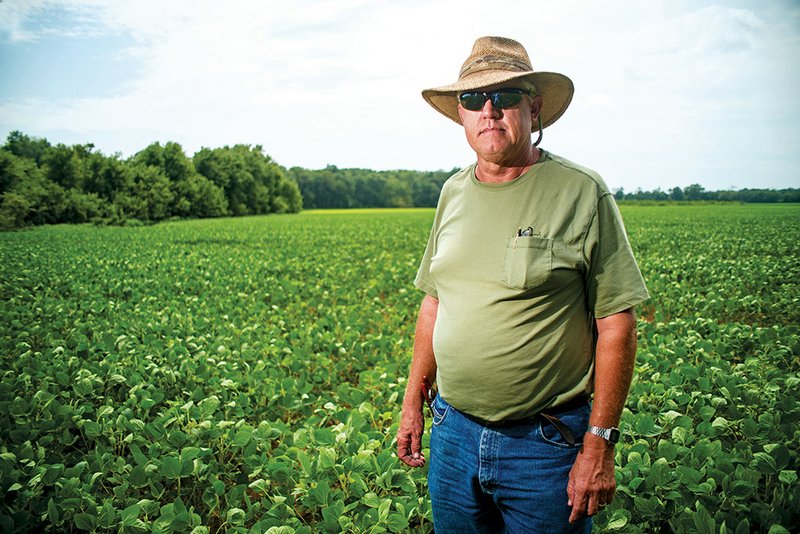Overlooking fields with plants that are too short and dead spots overgrown with weeds, R.J. Peacock said it has been a year of strange weather for Arkansas farmers.
“Never seen a year like this,” he said, adding that other farmers who have been at it longer than he has have said the same thing.
Peacock farms 1,600 acres of soybean and rice north of Bald Knob, and the Peacocks were named White County Farm Family of the Year in 2008. Peacock’s family moved to Arkansas in 1901 and started farming, and now he and his son, Brad, work his piece of land.
This season has been hard on the farm. The damage Mother Nature has brought to the farm — which borders the White River — has resulted in Peacock losing 60 acres of his crops this season.
On Aug. 7, the ground was cracked, and Peacock said he was hoping for a good rain. Still, low spots showed where the 6 inches of rain resulted in standing water that had killed young seedlings when the area flooded earlier this summer. Weeds grew in those areas, and looking out over a sea of dark-green bean plants, Peacock could point to the lighter patches of intruding growth.
“You just gotta let the river do what it’s going to do,” Peacock said of the floods earlier in the growing season. “There’s nothing you can do about it.”
Some of the neighboring farmers had delayed planting their crops. Peacock said most years he is through planting around June 1-5, but some of his neighbors had to wait well into August before planting. Others got 8 to 10 inches of rain, ruining 2,000 acres of crops.
Brian Haller, county extension agent staff chair with the White County Cooperative Extension Service, said crops planted later will most likely be harvested later. Farmers who put their seed in the ground late face two obstacles as the year moves on: Colder temperatures and shorter periods of daylight.
“It all depends on how our fall goes,” Haller said. “The further out you get with those smaller plants, the less sunlight they get. When you get off into the later months, they don’t grow as quick.”
Unfortunately, farmers purchase soybean seeds the winter before they plant. Haller said the seeds don’t keep from year to year, so they have to use it or lose it.
Rain has impacted other crops as well. Haller said farmers have a hard time harvesting wet hay, and one of the farmers he works with who grows corn turned on their irrigation system for the first time last week.
“On one side of that, irrigation costs are low this year,” he said. “But a lot of crops probably didn’t get in in a timely manner.”
Planting later crops also increases the potential of insects and diseases having a chance to take hold. Haller said army worms have been bad this year, and the weather is not helping to keep the crops healthy.
“This weather we’ve been having is ideal for diseases,” he said. “We’ve also had a lot of insects this year.”
On Peacock’s farm, the crops that were not impacted by the floods have not grown like they normally would. The cooler weather, coupled with the shifts from intense rain to dry-as-a-bone conditions, have stunted the soybean plants.
“These beans right here should be twice as high as they are right now,” he said as he drove his truck along the gravel road that winds through part of the farm.
Peacock said the impact of the weather will economically affect the farmers and people who work with them. Consumers may not see increases in supermarket prices, Peacock said, but others who do business directly with the farmers may be impacted.
“Everything with the weather is a step-down thing,” he said. “It hurts us. It hurts the banks.”
After a request from Gov. Mike Beebe, U.S. Secretary of Agriculture Tom Vilsack recently made disaster declarations for farmers and ranchers in 10 Arkansas counties because of flash flooding, excessive rain, high winds, hail and dangerous lightning, beginning on June 29. The counties include Cross, Independence, Jackson, Lee, Lonoke, Monroe, Prairie, St. Francis, White and Woodruff.
“I appreciate Gov. Beebe’s and Secretary Vilsack’s quick response to this agricultural disaster,” Arkansas Secretary of Agriculture Butch Calhoun said in a press release. “The unprecedented amount of rainfall at this critical time of year for agriculture has cost Arkansas farmers a tremendous amount in lost crops that can’t be replanted and input costs that can’t be recovered.”
The disaster declarations mean federal aid, including emergency loans, is now available for qualifying farmers.
Additionally, a declaration providing flood-related aid applies to 13 counties contiguous to the region including Arkansas, Cleburne, Craighead, Crittenden, Faulkner, Izard, Jefferson, Lawrence, Phillips, Poinsett, Pulaski, Sharp and Stone counties.
Peacock said it could be awhile before aid gets to the farmers. He has crop insurance, and if things get worse, he might reach out to his insurance agent.
His crops are not where they are supposed to be at this time, but Peacock said there is still a chance for recovery. Yields could be down this season, but soybeans are not harvested
until October or November, and if this autumn is mild instead of cold, some of the plants could continue to grow. Peacock said the temperature needs to stay above 45 or 50 degrees for a good growing season.
For now, Peacock said, he and his son will continue to work hard and pray for just enough rain, favorable temperatures and a good, strong season next year.
Staff writer Angela Spencer can be reached at (501) 244-4307 or aspencer@arkansasonline.com.
